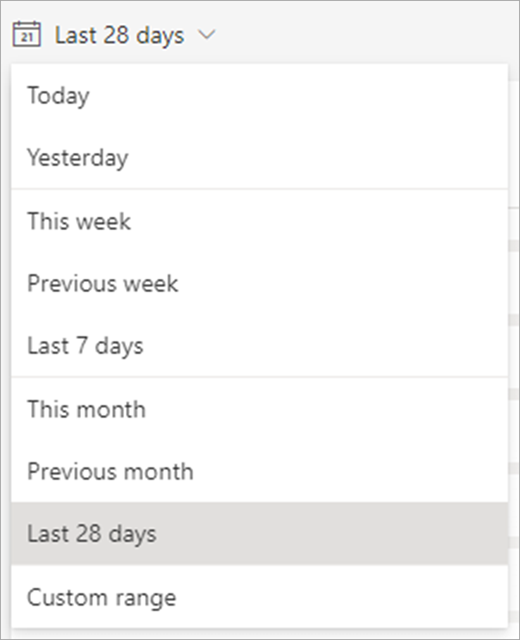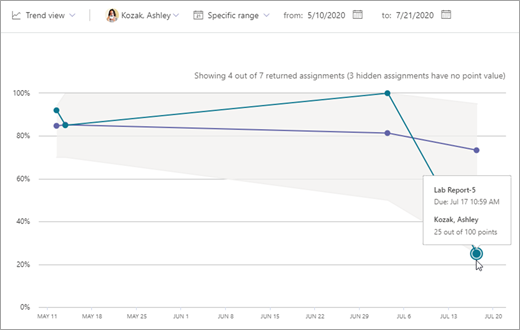The Grades report gives you a sense of how performance is distributed across the class, both by student and by assignment. You can also track how a student compares to the class and their grade performance over time.
Filter
By default, your report reflects all students and assignments in the last 28 days. Use filters to customize your report. Select the dropdown arrows
-
Student filter: type a student's name in the Search student box to only see data about that individual student.
-
Assignments filter: View all assignments or select individual assignments to view or compare.
-
Time filter: select Last 28 days to open a dropdown of additional timeframe options.
-
Select Custom range to enter your own timeframe that can show up to one year of past grades and insights.
-
Read your data
You can view your Grades report in Distribution view or Trend view. Select the dropdown arrow
Note: Only graded assignments are included in the report. To easily compare the data for these assignments, the grades are normalized. This means that for each assignment, the grades are shown as if they were graded out of 100 points. For example, if there are 5 points available for a quiz, someone who earned 4 points is shown as receiving 80 points.
Distribution view
-
Grade distribution of grades is represented by bars. When you select an individual student, their grade range is shown in a new bar with a different shade, so you can compare their range to the rest of the class.
-
Hover over the bar to see how many students are in the grade range, what the student’s average grade is, and how many graded assignments are included.
-
Select a bar to filter the student list on the right to only show students in that grade range.
Trend view
-
Use the trend view to look at a specific student’s performance for all assignments. One line represents the class average grade, while the other line represents the student's average.
How average grade is calculated
Scenario: You set a test to be worth 5 points, a quiz to be 10 points, and a report to be 100 points.
-
Adam received 4 points in the comprehension test, 10 points in the quiz, and 80 points for the report.
-
Insights adds up the points that Adam received (1+10+80) and divides them by the available points (5+10+100). 94/115 = 82 (rounded to the nearest digit). So Adam's average grade is 82.
We repeat the process for all students, add up their average grades, and divide by the number of students to get the class average.
Export your data
-
In your report, select More options
-
Select Export to Excel.
-
The Assignments sheet contains a list of students, and for each assignment, you see the grade (if graded with points).
The Summary sheet provides a student’s average grade for that class.
Note: You can view the selected time frame for your exported data in the Excel file name.
Classroom use cases that you can act on using your Grades report:
-
Observing a student's grades over time can be a useful way to check in and see if they need help.
-
In the distribution view, the distribution of grades for a specific assignment—whether grades are unusually high or low—can help you adjust future assignments and assessments.
-
The grade distribution view can be helpful if you want to designate specific assignments for groups of students in similar grade ranges.
Learn more
Digital activity data in Insights
Communication activity data in Insights


















